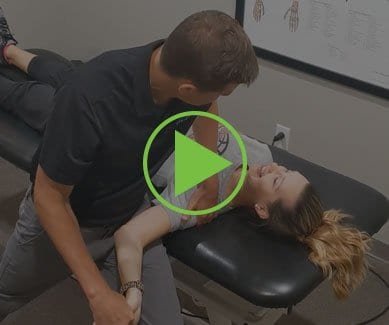Top Clinical Pearls For Radicular Arm Pain
Reading time: 6 minutes
Patients often associate pain with muscle, tendon, or ligament injury. However, irritated nerves may also become the primary source of pain. Tensile stretch or compression of nerves often results in symptoms. Unfortunately, radiculopathies are often the most difficult diagnoses to treat. Without quick symptomatic relief, patient compliance diminishes. Today’s blog will cover the diagnosis and treatment for the most common upper limb radicular symptoms you may encounter in practice.
Achieve Quick and Measurable Results for Radiculopathies
This blog will discuss how to incorporate neurodynamic testing into your evaluation and management of radicular arm pain. Keep in mind that there are standardized upper limb nerve tension tests as defined by Shaklock. Neurodynamic tests, like orthopedic tests, used in isolation are not overly specific or sensitive. However, utilizing multiple tension tests may rule in cervical radiculopathy. Also, consider the work of Grondin et al. (2021), who found that you can RULE OUT cervical radiculopathy if all of these tests are negative.
Nerve Tension Tests Serve Four Primary Roles
1. Evaluation (Nerve Tensioning)
Nerves are dynamic structures that need to glide and stretch. (2) Edema and fibrosis can impair this normal movement and often translates into neurogenic complaints. Symptomatic nerve roots are wider than asymptomatic nerve roots due to the presence of edema. (3)
You would not consider evaluating sciatica without a neurodynamic test (straight leg raise), so why wouldn't you consistently do the same for upper extremity complaints. The following tests can allow you to identify irritated primary tracts quickly:
2. Management (Nerve Flossing)
Nerve flossing aims to restore normal neurodynamics and may help resolve the associated symptoms. Flossing entails tensioning one end of the nerve while simultaneously releasing the tension on the other end. This repetitive motion glides the nerve back and forth through its path and aims to release adhesions that have developed along the way. Nerve flossing is an in-office treatment, then incorporated into a home care program.
Clinicians may perform in-office nerve flossing of the Radial Nerve at the Elbow, Median Nerve Release at the Pronator Teres, and Ulnar Nerve at the Elbow.
Check out the following at-home self-floss exercises
3. Clinical Audit Process (CAP)
The clinical audit process measures how a condition changes as a result of treatment. Most chiropractors use range of motion (ROM) as their primary clinical audit process. For example, a patient may have pain with lumbar flexion at 25 degrees. After spinal manipulation and lumbar traction, the ROM has increased to 55 degrees before reproduction of pain. It appears treatment was successful with measurable improvement in lumbar ROM.
Nerve pain is often slower to subside as compared to ROM. For radiculopathies, consider using nerve tension tests as your CAP. Improvements in radicular pain will improve post-treatment if you have selected the correct intervention. In-office care that diminishes the compression or stretch of the irritated nerve will result in reduced pain with subsequent centralization of symptoms.
Watch our friend Dr. Taylor Premer of Winchester Spine and Sport and Gestalt Education explain how nerve tension signs are affected by directional therapy in the cervical spine.
Chiropractors should perform nerve tension tests before and after treatment. Your treatment will vary based on the diagnosis and your skillset. Always select treatments that positively affect the post-treatment audit. Treatment options including spinal manipulation, traction, nerve flossing, directional therapy, and soft tissue manipulation are all well-established treatments for cervical radiculopathy. If treatment does not positively affect the nerve tension test post-intervention, then it's time to reconsider your treatment pathway!
4. Patient Education
Patient compliance and satisfaction will improve when your treatments diminish pain and improve function. Patients will trust your assessment and comply with your care if you can demonstrate short-term success for challenging diagnoses. Measuring progress will boost confidence in your in-office and at-home exercise selection for radicular pains.
Are you looking for an easy way to educate your patients? You're going to want to check out ChiroUp. And before you ask, no. We are not an exercise program; we are so much more.
ChiroUp V3 is a system that improves patient compliance with our reports, tracks your clinical outcomes, and, most importantly, builds a relationship with every patient that you see. All in a matter of seconds.
Sign up for your FREE 14-day trial today!
-
Grondin F, Cook C, Hall T, Maillard O, Perdrix Y, Freppel S. Diagnostic accuracy of upper limb neurodynamic tests in the diagnosis of cervical radiculopathy. Musculoskeletal Science and Practice. 2021 Oct 1;55:102427.
Wilgis EF, Murphy R. The significance of longitudinal excursion in peripheral nerves. Hand Clin. Nov 1986;2(4):761-6.
Okmen BM. et al. Investigation of the Effect of Cervical Radiculopathy on Peripheral Nerves of the Upper Extremity With High-Resolution Ultrasonography. SPINE. 43(14):E798–E803, JUL 2018

